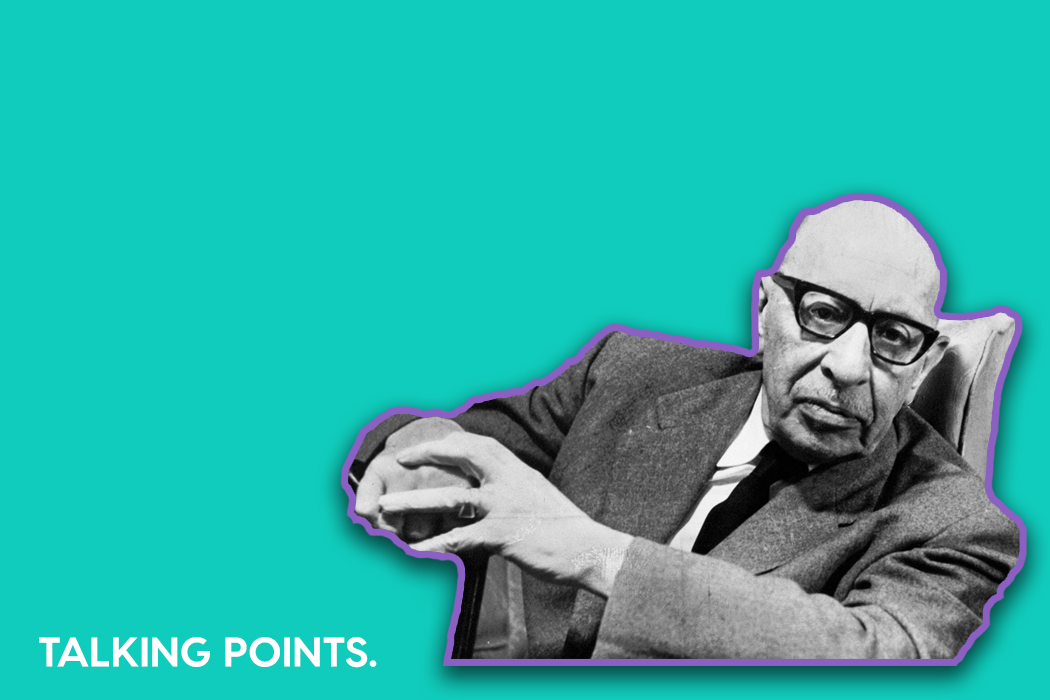
Welcome to Flypaper’s editorial column, Talking Points, where we revisit a lengthy lecture or Q&A with the greatest minds in music composition and production, and elucidate the most interesting details or concepts to gain a fresh perspective on the topic in question. In other words, we’ll pull out the talking points. Follow along with the series here.
In this edition of our series, we’re going to go in a slightly different direction: backwards! We’ll take a look at a funky little 1957 film featuring some strange yet thought-provoking conversation with one of the greatest 20th-century composers to have lived, Igor Stravinsky. Known most widely for writing masterworks like The Firebird, The Rite of Spring, and his folk ballet, Petrushka, Stravinsky also worked with some of the greatest multidisciplinary artists of his generation, such as Pablo Picasso, George Balanchine, and Jean Cocteau, among many others. Here, the composer is filmed in his domestic habitat, Hollywood, with conductor Robert Craft steering the ship, and often also getting caught in its tangly sails.
Hey, at least this interview didn’t go like Stravinsky’s 1965 chat with The New York Review:
New York Review: We hope you are enjoying your stay in New York, Mr. Stravinsky. Have you attended any interesting concerts or other performances?
I. S.: No concerts.
Yikes. Awkward! As entertaining as it is informative, there’s a ton of useful info and insight in this talk for the modern composer and musical thinker to take away, so skip the lengthy video and join me below for the talking points!
1. “You have to touch the music, not only hear it.”
Oooookay! Right out the gate, we got a live one. Music is about vibrations, and feeling them as you play it. So says Mr. Stravinsky somewhere inside of a kooky tale about the elder and nearly entirely deaf Beethoven sticking a pencil in his mouth to feel the vibrations of each note as he composed them. Anyway, he’s onto something.
As composers, so much of the “job,” if you will, exists inside our own heads. It’s an internal battle of intent, intuition, anxiety, and stress, and sometimes explosive creativity. But on top of that exists the actual work of writing it down and communicating all that madness to a single performer. Writing music is nerve-racking. How does this really look? How does it sound to someone other than myself?
One great way to make sure you’re keeping yourself grounded in reality, and able to step outside the chaotic landscape of your brain, is just to play as you write. Feel it, feel the notes clash together as they ring out, and experience each utterance of sound under that bodily microscope of yours. If it feels good, it is good.
2. C, D, E, G, F, B
Stravinsky makes a brief point about “invention” as composition. Regrettably, the pair doesn’t really dwell on the subject, but the composer talks about how when he was younger and he heard the C major scale, he would immediately begin brainstorming ways he could make it his own — break the rules. Let’s skip F, go straight to G, then back to F and flop over to B before landing back at the tonic — why not? It reminds me of Picasso’s famous quote: “Learn the rules like a pro, so you can break them like an artist.”
But it also reminds me of something Soundfly composition instructor Tim Hansen writes in this great advice column, that music’s only meaning is the meaning we attribute to it. What good is a C major scale if it doesn’t mean anything to you?
3. Harmony is dull, but counterpoint, very interesting.
We might not agree with this one necessarily (we’re kind of obsessed with harmony), but Stravinsky basically lays out how bad of a pupil he was for his teacher, Nikolai Rimsky-Korsakov. He mentions that he lagged behind on assignments from his teacher because he simply wasn’t interested in everything he was being taught. Any normal teacher might get discouraged, but somehow Rimsky-Korsakov made it work. He introduced Stravinsky to folkloric forms, which were more heavily steeped in melodic material than harmonic, and that would go on to inspire his masterworks later on.
But the teacher also made a pretty daring judgment call (especially for the early 1900s), which was to suggest Stravinsky not attend the conservatory. Stravinsky says he was all but overjoyed to hear this, considering he didn’t want to go anyway. This speaks to how much we all have our own ways of learning, our own interests, and our own goals to achieve. The right direction forward doesn’t always align with the assumed path that others have laid.
And this truth is of course a foundational principle that we here at Soundfly believe about education, especially when it comes to self-education (like, for example, opting to take an online course).
4. “We use technology as a material for our musical art.”
Yup, you heard him say it! Stravinsky, ahead of his time, producer. As composers, songwriters-producers, and music-makers of all types, we cannot really deny the function or materiality of the media on which we deliver our art anymore. How people hear the music of today is just as much a part of the experience as the notes on the page. Knowing the technologies that will become part of the dissemination of a work will help shape the genesis of that work through the entire compositional process.
5. A mistake, or just a new approach?
Craft asks Stravinsky about his habit to confound his audiences on first listen, referencing the famously horrified reactions at the 1913 premier of The Rite of Spring. His answer was that he can understand how audiences have certain expectations, and when those expectations are eschewed or ignored, the audience is left wondering, “Is this some kind of new artistic language, or is this just bad music?”
Remember this whenever you’re cognizant that a part you’re composing includes a challenging moment for your audience, and make sure to responsibly weigh your choices. Do you go all in, do you try to sneak something subtly discolored inside something a bit more bright, or do you try to find ways to normalize that off-kilter idea and reframe the focal point of the piece?
All options are yours to play with, as long as you execute with confidence.
Improve all aspects of your music on Soundfly.
Subscribe to get unlimited access to all of our course content, an invitation to join our members-only Slack community forum, exclusive perks from partner brands, and massive discounts on personalized mentor sessions for guided learning. Learn what you want, whenever you want, with total freedom.




